Always-on: AR is changing the game for retail
Augmented reality has been on the cusp of mainstream appeal for some time. Now, as AR technology becomes ubiquitous and consumers demand ‘always-on’ marketing opportunities, OMM’s head of growth Tony Mohammed argues AR is about to radically change retail.

You will have heard lots about virtual and augmented reality over the past couple of years. Despite all the disruption of the past few months, these two digital technologies are still set to become even more relevant tools to reach audiences.
One of our main focuses over recent years has been virtual and mixed reality experiences using VR and AR for retail and events. VR for many consumers still holds that sense of wonder and delight when they try it for the first time. It has a unique place in the world of digital technology being an immersive sensory experience that transports consumers to alternate realities. Its real-world applications are also numerous; it allows tours of spaces that have yet to be built for architects and real estate agents, the presenting of detailed retail concepts to brands, and new design workflows within the industrial design and automotive industries.
Augmented reality offers us the chance to enhance the real world with a range of possibilities equal to – or larger than – VR, across both work and play. Whether it’s trying on new outfits before purchase, previewing how furniture would fit into your living room or simply playing games with your family. These immersive aspects of AR help to forge emotional connections with consumers, which in turn leads to brand engagement and all-important social sharing of content.
Dedicated hardware such as Magic Leap and Microsoft’s Hololens 2 can be used for a variety of experiences, however one of the most interesting and beneficial developments has been the use of AR in the Healthcare industry. GigXR for example have been pushing the boundaries of conventional medical education with HoloPatient, their mixed-reality product allowing a set standard of education to be rolled out across different medical schools.
Magic Leap is one of the companies leading the charge – making a huge investment into AR technology. The AR glasses, of course look super cool, but what is even more interesting is that they are currently developing the MagicVerse, which is their vision for a positive, ethical version of The Matrix. It is Magic Leap’s attempt to bring a cross platform XR system to the masses. Which means consumers can use the Magic Leap Spatial Goggles, on their iPad, iPhone or Android device. It’s a single AR platform that can be used across all devices and operating systems.
Alongside products and experiences designed for dedicated hardware, AR has made the leap onto a platform much more accessible for all of us – the mobile device.
The new iPad Pro includes the LiDAR camera, whilst this is not a new technology, the inclusion in the Apple device opens up a lot more AR opportunities. Apple combines depth information from the LiDAR scanner with camera and motion sensor data. This makes the new iPad Pro faster and more accurate at placing AR objects and tracking people’s location, all of which leads to better AR experiences.
In addition, frameworks such as iOS AR kit, Google ARCore and Amazon Sumerian have democratised Mobile AR and grown its install base considerably, more than tripling the number of active users in the last 18 months. Downloadable apps such as IKEA Place and Dulux’s Paint visualiser have developed have leveraged mobile technology to great effect.
Besides AR Kit & AR Core we can't forget the platforms we use everyday, for example, Facebook that have their own software called SPARK AR to create AR experiences for Facebook, Instagram & WhatsApp. Similarly, Snapchat’s Lens Studio is used to create amazing AR filters and worlds, that currently gives them the edge over Facebook’s Spark AR.
Sitting alongside the app-based Mobile AR is WebAR – experiences and games that run directly in your mobile’s browser rather than having to download a dedicated app. The rapid evolution of WebAR technologies such as 8th Wall is a game-changer as they break down the barrier to entry for consumers, needing just their mobile phone to get involved.
With a number of industries and sectors keen to explore its uses and benefits, the uptake within the marketing sector in particular has taken off. WebAR has huge potential to connect consumers with brands in new and meaningful ways.
A good example of this is the AR Gifting campaign we created for Nike’s Factory Store team in the run up to Christmas. Using their mobile device consumers were able to shoot hoops in our Augmented Reality Basketball game to unlock prizes and discounts. This created a closer relationship with Nike and boosted NikePlus Membership.
As these types of activations become more mainstream it is natural for brands to invest in a technology that allows consumers to experience their products no matter where they are via their mobile device. WebAR will shape the future of commerce as consumers increasingly demand ‘always-on’ marketing experiences they can interact with.
We see huge potential for the fashion industry and are currently developing several concepts in this area. We are excited to see how other agencies and brands will use these creative technologies to meet the needs of consumers across a range of industries.
As we have seen of late the world around us can change overnight, and with change comes the opportunity to adapt to consumer needs and the environment they live in. Expect a new world of AR engagement in the not too distant future.
Tony Mohammed, head of growth, OMM
